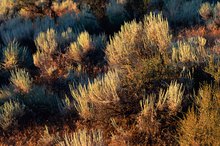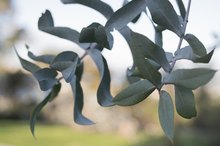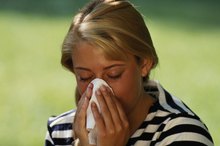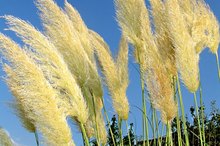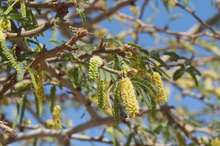Common Allergies in August & September
Seasonal allergies affect more than 35 million Americans, states the American Academy of Allergy Asthma and Immunology. Symptoms consist of sneezing, stuffiness, runny nose, nasal itching, throat itching and eye or ear irritation. Seasonal allergies that occur in August and September are often due to pollen and molds but can vary from one person to another and by region. Treatment consists of medication and allergen avoidance.
Plant and Tree Pollen
Various plants, including flowers, and trees pollinate from February through October suggests the American Academy of Allergy Asthma and Immunology. Some plants pollinate more in the spring while others do so in the fall months, such as August and September. In warmer climates the pollinating season can last year-round. Visibly flowering plants and flowers themselves aren't the primary source of pollen allergies because these pollens aren't airborne. Instead, these flowers rely on insects and birds to transport the pollen for fertilization. Other types of flowers and trees do produce colorful petals with dry pollen that is spread by the wind.
- Various plants, including flowers, and trees pollinate from February through October suggests the American Academy of Allergy Asthma and Immunology.
- Instead, these flowers rely on insects and birds to transport the pollen for fertilization.
Weed or Grass Pollen
Palm Tree Allergy
Learn More
Like other flowering plants, grass and weeds produce pollen that is airborne. This type of seasonal allergy, commonly called hay fever, is caused by ragweed pollen. Weeds and grass produce pollens that are carried into the wind to fertilize other plants and land elsewhere. Individuals can pick these pollens up by being outdoors or a pet can bring them into the home. Calgary Allergy Association explains that raw bananas, melons, watermelon, cantaloupe and any other gourd can trigger ragweed allergies in August and September. Individuals with grass allergies may experience a reaction to watermelon, tomato, kiwi or peaches.
- Like other flowering plants, grass and weeds produce pollen that is airborne.
- Individuals with grass allergies may experience a reaction to watermelon, tomato, kiwi or peaches.
Molds
Mold spores can be found indoors as well as outside. Common outdoor sources of allergies include fungi species found naturally in the environment, molding soil or rotting wood. Inside, mold can grow in any warm climate that provides moisture as well. As soon as temperatures increase, mold can begin growing and emitting spores into the environment. Climates that are warm year-round aggravate individuals with mold allergies.
- Mold spores can be found indoors as well as outside.
- Inside, mold can grow in any warm climate that provides moisture as well.
Related Articles
References
- Calgary Allergy Association: Oral Allergy Syndrome
- American Academy of Allergy, Asthma and Immunology.
Writer Bio
Sarah Harding has written stacks of research articles dating back to 2000. She has consulted in various settings and taught courses focused on psychology. Her work has been published by ParentDish, Atkins and other clients. Harding holds a Master of Science in psychology from Capella University and is completing several certificates through the Childbirth and Postpartum Professional Association.


